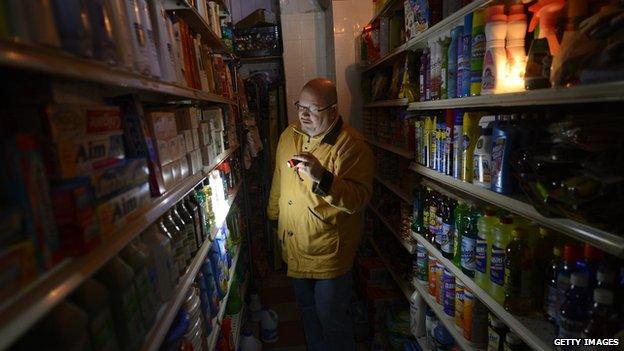Super-storm Sandy survival guide
- Published

In the East Village of New York, even shops don't yet have power, and won't for at least four days
Though the flood waters are receding, millions of US citizens will remain without electricity until the end of the week or longer. Here's how to cope when the lights go out.
Sandy has blown north, but for people living on the US east coast, the effect of the storm's wrath lingers. Aside from the billions of dollars of property damage, thousands of people from Maine to Tennessee are now facing prolonged blackouts.
In some cases, like suburban Philadelphia, it's often just a case of repairing downed power lines, and many customers had electricity turned back on within 24 hours.
But in New York City, where one power plant exploded in spectacular fashion after taking on too much flood water, residents may be in the dark for much longer.
A blackout may conjure up romantic images of reading by candlelight, but most power outages are a more modern affair.
First of all, candles are frowned on by many emergency experts.
"You have to be cautious. If that's all you have, than that's what you've got to use, but they pose a fire risk," says Robert Emery, vice-president of safety, health, environment and risk management at The University of Texas Health Science Center at Houston. Dr Emery also notes that the build up of gasses created by burning too many candles for too long can be unhealthy.
In urban areas, fires started by candles can spread quickly.
Instead, the standard recommendation is battery-operated flashlights and lanterns - as well as hand-cranked radios and solar chargers to keep your mobile and other electronic devices charged.
The best way to communicate to family members and friends is via text, says Janet Liebsch, author of the book It's A Disaster... And What Are You Gonna Do About It?. Text messages takes less power and has a higher chance of going through during times of peak call volume, as is often the case in a blackout.
Both a smartphone and the radio are often the best way to find out updates on dangerous weather and to keep tabs on the post-storm efforts to restore electricity.
Dr Emery notes that sometimes power failures can lead to unsafe drinking water, so it's important to listen for announcements on water safety.
If you lack a solar charger, keep an eye out for local charging centres - for instance, in Plymouth Meeting, Pennsylvania, the local Whole Foods market kept the store closed, but opened its cafe, providing free snacks and offering electrical hookups to those still in the dark.
For those without access to a friendly and generous local market, sorting out which food is fresh and which will spoil is another crucial blackout task.
Though the US Department of Agriculture recommends throwing out all perishable items after four hours without refrigeration, Katherine Kosa, of research analyst RTI International, acknowledges that "some people think that rule is ridiculous".
Meteorologist Paul Heppner explains why Sandy has been so destructive - aerial footage shows scene on New Jersey coastline
She says a better rule of thumb is to take the internal temperature of raw and cooked meats, milk and other items that can spoil - anything under 4.4C (40F) is safe to eat.
"If it's above 40F, that's when bacteria could start to grow," she said, noting that the internal temperature is a much more accurate measure than a smell or taste test. Uncut fruit and vegetables can be kept at room temperature, as can most condiments (except for mayonnaise).
A freezer full of food will keep fresh for 48 hours, a half-filled freezer keeps for 24, says Kosa, who recommends keeping doors of both freezers and refrigerators shut for as long as possible to keep the cold air trapped.
If you have a sense of an impending power outage, Liebsch recommends filling any empty freezer space with containers of water ahead of time.
"It keeps the cold in there, and as it thaws you'll have water to use," she says.
Perhaps the best tip for anyone facing a blackout is to stay calm and be patient. Dr Emery says that many outage-related injuries occur when people get cabin fever and head outside before conditions are safe, or try to do the work of a professional response team.
"We see people injured by downed power lines and electrical circuits, cuts to inexperienced people using chain saws to remove downed trees. Slips, trips and falls - when the street lights are out, it's difficult to navigate the streets safely."
The good news is that for most people in most cases, the lights eventually go back on. Until they do it's best to be prepared, keep yourself busy, and if all else fails, go to bed early.